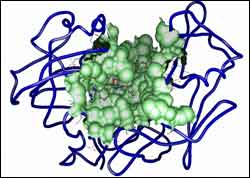Here you can find a summary of innovations in the fields of information and data processing and up-to-date developments on IT equipment and hardware.
This area covers topics such as IT services, IT architectures, IT management and telecommunications.

Researchers at the Department of Mechanical Engineering, Energetics and Materials at the Public University of Navarre are working on the implementation of a fork-lift truck simulator for training purposes and aimed at minimising the risks involved in their use in the workplace. The project, led by Department member Jesus Maria Pintor, is being undertaken after being commissioned by the Navarre Government’s Institute of Occupational Health and forms part of a wider project, started in 2002, on work

Using mobile telephones in hospitals reduces the error rate in medical care because of more timely communication and rarely causes electronic magnetic interference, Yale School of Medicine researchers report this month.
The study published in February’s Anesthesia & Analgesia is believed to be the first to investigate whether use of cell phones by medical personnel has a beneficial impact on safety. It was based on 4,018 responses from attendees at the 2003 meeting of the

An object’s history and how it arose, in other words its provenance, grant it status. Translating this to computing will allow the information generated and managed within distributed networks to be proven and trusted. Laying the foundations for this translation is a team of European researchers.
The importance of understanding the process by which a result was generated is fundamental to many real-life applications in science, engineering, medical domain, supply management, etc. W

The EUREKA project E! 2288 on Computer-aided orthopaedic care (MEDAC) is helping orthopaedic surgeons to not only document their clinical cases, but to also manage and analyse all patient data compiled. This award-winning project is revolutionising orthopaedic research and could be applicable to many other specialist areas of medicine. Patients benefit from a fast and documented diagnosis, while surgeons gain access to vast resources of reference data and the means to analyse their own patients

Researchers at Ohio State University have found a way to boost the development of pattern recognition software by taking a different approach from that used by most experts in the field.
This work may impact research in areas as diverse as genetics, economics, climate modeling, and neuroscience.
Aleix Martinez, assistant professor of electrical and computer engineering at Ohio State, explained what all these areas of research have in common: pattern recognition.

Subtropical diseases lay waste to millions of people each year. In the quest to find a cure scientists are using Grid computing, the major driving force for new approaches towards collaborative large-scale science, to discover new drugs and better understand the diseases.
Last year there were about 350-500 million infections and approximately 1.3 million deaths due to malaria, mainly in the tropics. Malaria is spread by female mosquitoes, which carry protozoan parasites called Pla